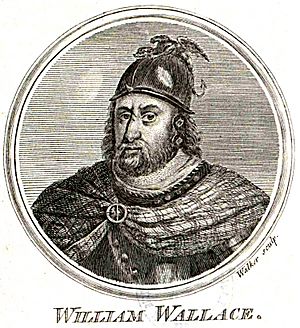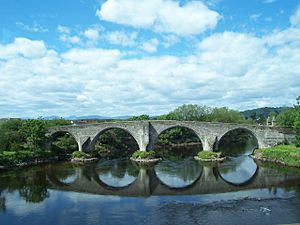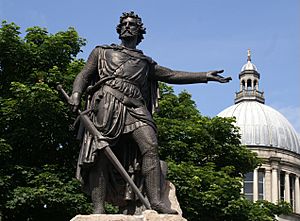William Wallace facts for kids
Quick facts for kids
William Wallace
|
|
|---|---|

Portrait from c. late 17th–18th century
|
|
| Guardian of the Kingdom of Scotland (Second Interregnum) |
|
| In office 1297–1298 |
|
| Preceded by | John Balliol (as King of the Scots) |
| Succeeded by | |
| Personal details | |
| Born | c. 1270 Elderslie, Renfrewshire, Kingdom of Scotland |
| Died | 23 August 1305 (aged c. 35) Smithfield, London, Kingdom of England |
| Cause of death | Executed |
| Resting place | London, in an unmarked grave |
| Spouse | Marion Braidfute (disputed) |
| Children | None recorded |
| Occupation | Military leader |
| Military service | |
| Allegiance | |
| Years of service | 1297–1305 |
| Rank | Commander |
| Battles/wars | |
Sir William Wallace (born around 1270 – died 23 August 1305) was a Scottish knight and a very important leader. He helped Scotland fight for its freedom during the First War of Scottish Independence.
Along with Andrew Moray, Wallace led the Scottish army to a big victory. They defeated an English army at the Battle of Stirling Bridge in September 1297. After this, he became a "Guardian of Scotland," which meant he helped rule the country.
However, he was later defeated at the Battle of Falkirk in July 1298. In August 1305, Wallace was captured near Glasgow. He was then given to King Edward I of England. King Edward had Wallace put to death.
Even after his death, William Wallace became a hero. He is famous far beyond Scotland. He is the main character in an old poem called The Wallace. He is also the subject of books and the famous movie Braveheart.
Contents
Who Was William Wallace?
William Wallace came from a noble family, but we don't know much about his parents. A seal found on a letter from Wallace in 1297 shows his father's name was Alan Wallace. This Alan might have been a landowner in Ayrshire.
Some people think William was born in Elderslie, Renfrewshire. Other records suggest his family had lands in different parts of Scotland. These lands were often connected to a powerful Scottish family called the Stewarts.
The name "Wallace" likely comes from an old English word meaning "foreigner" or "Welshman." This might mean his family came from Wales. Or, it could mean they were from a part of Scotland where people spoke a different language.
Scotland's Fight for Freedom
A Time of Trouble in Scotland
When William Wallace was young, Scotland was a peaceful country. It was ruled by King Alexander III. But in 1286, King Alexander died after falling from his horse.
His granddaughter, Margaret, Maid of Norway, was supposed to be the next queen. But she was a child and lived in Norway. Scottish leaders set up a group to rule the country. Sadly, Margaret died on her way to Scotland in 1290.
This left Scotland without a clear ruler. Many people claimed the throne. The two main people were John Balliol and Robert Bruce. Scotland was close to a civil war.
To help decide, the Scottish nobles asked King Edward I of England to step in. But Edward said he would only help if they agreed he was the "Lord Paramount of Scotland." This meant he would be in charge.
In 1292, Edward chose John Balliol to be the new King of Scotland. But Edward kept trying to control King John. He treated Scotland like it was his own land. He even made King John appear in English courts.
The Scottish leaders grew tired of King John being controlled by Edward. They formed a new council to rule. They also made a treaty with France, called the Auld Alliance. This meant France and Scotland would help each other.
King Edward I was angry about this treaty. He invaded Scotland in 1296. His army captured the town of Berwick-upon-Tweed. The Scots were defeated in a battle at Dunbar.
Edward then forced King John to give up his crown. This happened in July 1296. Edward made many Scottish nobles promise loyalty to him.
Wallace's Early Actions
Historians believe Wallace had some military experience before 1297. He might have fought as a soldier for hire. His personal seal shows an archer, suggesting he might have been a skilled archer.
Wallace was described as a very tall and strong man. Some stories say he was seven feet tall!
The first known action by Wallace was in May 1297. He killed William de Heselrig, the English Sheriff of Lanark. After this, he joined with another Scottish leader, William the Hardy, Lord of Douglas. They attacked a place called Scone.
Many other rebellions were happening in Scotland at this time. One important leader was Andrew Moray in the north. Many Scottish nobles gave up their fight against the English in July. But Wallace and Moray kept fighting.
Wallace used a forest as a base for his attacks. He and Moray later joined their forces. This probably happened while they were attacking Dundee.
The Battle of Stirling Bridge
On 11 September 1297, Wallace and Andrew Moray led the Scottish army to a huge victory. This was the Battle of Stirling Bridge. The Scottish army was much smaller than the English army. But they still won!
The English army had thousands of soldiers and cavalry. They tried to cross a narrow bridge. Only a few soldiers could cross at a time. The Scots waited until about half the English army had crossed. Then, they attacked quickly.
The Scottish soldiers used their schiltron formations. These were tight groups of spearmen. They pushed the English infantry back. The bridge could not hold the weight and collapsed. Many English soldiers drowned.
This was a very important victory for Scotland. It gave the Scottish army great confidence. After the battle, Moray and Wallace became the Guardians of Scotland. Sadly, Andrew Moray died from his wounds later that year.
Around November 1297, Wallace led a large attack into northern England. He was also made a knight in a ceremony.
The Battle of Falkirk
In April 1298, King Edward I of England invaded Scotland again. He had a very large army. The English army attacked parts of Scotland. But they could not get William Wallace to fight them.
The Scots wanted to avoid a big battle. They hoped that Edward's army would run out of supplies. Then, they would attack the English as they retreated. Edward's army did have low supplies.
In July, Edward learned that the Scots were camped near Falkirk. He quickly moved to fight them. Wallace arranged his spearmen in four schiltrons. These were strong, circular formations of soldiers with spears.
However, the English had many skilled Welsh longbowmen. These archers were very good. They shot arrows at the Scottish formations. The Scottish cavalry also left the battle.
Gaps started to appear in the Scottish schiltrons. The English soldiers used these gaps to break through. The Scots lost many men. Wallace escaped, but his reputation as a military leader suffered.
After this defeat, in September 1298, Wallace stepped down as Guardian of Scotland. Robert the Bruce (who would later become king) and John Comyn took over.
Wallace's Later Years and Capture
We don't know much about what Wallace did after Falkirk. Some evidence suggests he went to France. He might have asked the French King Philip IV for help for Scotland. There is a letter from the French king that mentions helping Sir William.
By 1304, Wallace was back in Scotland. He was involved in smaller fights.
Wallace managed to avoid being captured by the English for a long time. But on 5 August 1305, a Scottish knight named John de Menteith turned him over to English soldiers. This happened near Glasgow.
Wallace was taken to London. He was put on trial in Westminster Hall. He was accused of treason and of harming civilians during the war. Wallace famously replied, "I could not be a traitor to Edward, for I was never his subject." This meant he never saw Edward as his true king.
On 23 August 1305, William Wallace was put to death. A plaque marks the spot where this happened in London. It has a Latin message that means, "I tell you the truth. Freedom is what is best. Sons, never live life like slaves." It also has a Scottish Gaelic battle cry: "Death and Victory."
In 1869, the Wallace Monument was built near Stirling Bridge. This monument honors William Wallace. The Wallace Sword, which some believe belonged to him, is now kept there.
See also
 In Spanish: William Wallace para niños
In Spanish: William Wallace para niños
- Clan Wallace
- Wallace's Heel Well – a stone with an imprint said to be Wallace's heel
- Wallace's Well – a well in Robroyston, Glasgow





